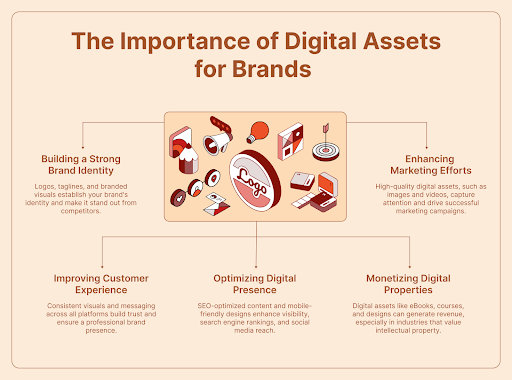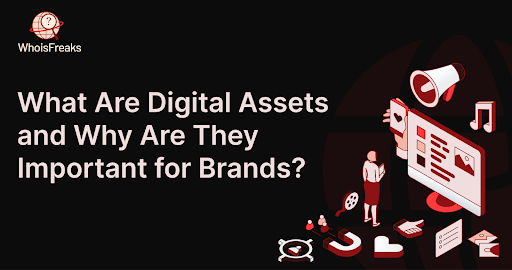Every business operates within a dynamic framework where technology and online engagement dictate the rules of success. For brands to remain relevant, competitive, and impactful, it’s essential to recognize and harness the power of digital assets. But what exactly are digital assets, and why have they become such a pivotal element of modern brand strategies?
Digital assets refer to any content or resource in a digital format that holds value for a brand—be it logos, marketing materials, customer data, or even social media profiles. These assets are far more than static entities; they are dynamic tools that enable brands to convey their identity, engage their audiences, and establish trust in an ever-evolving digital landscape.
For businesses looking to build, protect, and optimize their digital presence, some platforms provide essential tools, such as domain monitoring and privacy solutions. Domain names are critical digital assets, and managing them effectively ensures brand consistency and protects against cybersquatting or misuse.
This guide unpacks the essence of digital assets and explores their critical role in brand development. By understanding their importance, you can leverage these resources to enhance operational efficiency, increase visibility, and foster long-term growth. In an age where competition is fierce, mastering the management and utilization of digital assets is no longer optional—it’s an imperative.
What Are Digital Assets?
Digital assets refer to any content, media, or resource stored in a digital format that carries intrinsic or operational value for a business or organization. They serve as the foundation of a brand’s identity, marketing initiatives, and customer engagement strategies, playing a pivotal role in establishing a strong and impactful online presence. By managing these assets effectively, businesses can deliver their message, enhance their value proposition, and foster trust with their audience.
Here is a detailed breakdown of key types of digital assets:
- Images: This category includes logos, product photos, infographics, and other visual materials used in branding, advertising, and communication. High-quality visuals are essential for creating a professional and memorable brand identity.
- Videos: Video content, such as advertisements, tutorials, promotional clips, and live streams, is a powerful medium for engagement. It allows brands to tell compelling stories and educate their audience dynamically.
- Audio Files: From podcasts and voiceovers to jingles and sound effects, audio assets add depth to the sensory experience of your brand and are particularly effective in building emotional connections.
- Documents: Whitepapers, case studies, presentations, and eBooks are valuable tools for thought leadership and customer education, showcasing expertise and enhancing credibility.
- Web Assets: These include website files, domain names, and landing pages, which act as the digital storefront of your business. They are often the first point of interaction with your audience and play a crucial role in shaping perceptions.
- Social Media Content: Posts, stories, reels, and advertisements crafted for platforms like Instagram, Facebook, LinkedIn, and TikTok are key for fostering real-time engagement and interaction with your audience.
- Data Files: Customer data, market insights, and intellectual property fall under this category. Proper management of these files supports data-driven decision-making and strengthens competitive advantages.
Digital assets are far more than mere resources; they are strategic tools that communicate your brand’s mission, define its value proposition, and ensure a lasting online presence. In a world where digital-first impressions are critical to success, businesses must prioritize the effective creation, organization, and optimization of these assets to thrive.

The Importance of Digital Assets for Brands
Building a Strong Brand Identity
Digital assets serve as the foundation of your brand identity in the digital landscape. Logos, taglines, and branded visuals differentiate you from competitors and make your business instantly recognizable.
Enhancing Marketing Efforts
In marketing campaigns, digital assets like images, videos, and copywriting are essential for grabbing attention and conveying your message. High-quality assets improve engagement rates and conversion success.
Improving Customer Experience
A well-organized library of digital assets ensures consistency in how your brand interacts with its audience. Consistent visuals and messaging across websites, emails, and social media platforms build trust and professionalism.
Optimizing Digital Presence
With digital assets like SEO-optimized content, branded videos, and mobile-friendly designs, your brand can maintain a strong online presence. This boosts visibility in search engine rankings and enhances social media reach.
Monetizing Digital Properties
For many businesses, digital assets like eBooks, courses, and proprietary designs can be monetized to generate revenue streams. This is especially true for industries reliant on intellectual property.
Key Types of Digital Assets for Modern Brands
Visual Assets
Visual content remains a cornerstone of branding. These assets include:
- Logos: Central to brand identity.
- Photography: Product images, behind-the-scenes shots, and event photos.
- Graphics: Social media graphics, charts, and infographics.
Content Marketing Assets
Content fuels online engagement and lead generation. Examples include:
- Blog Posts: Informative articles that educate and convert.
- Videos: Explainers, tutorials, and promotional campaigns.
- Interactive Tools: Quizzes, calculators, or personalized tools for engagement.
Intellectual Property
Brands often own proprietary digital assets that hold significant value:
- Patented Software: Tools and apps owned by the brand.
- Databases: CRM data and email lists.
- Proprietary Research: Industry reports and analytics.
Social Media Assets
Your social media posts, reels, and paid ads represent a dynamic library of digital assets. These assets amplify campaigns, communicate updates, and build community engagement.
The Role of Digital Asset Management (DAM)
Managing digital assets efficiently is critical for any brand. This is where Digital Asset Management (DAM) systems come into play. A DAM system helps organize, store, and retrieve digital assets, ensuring easy access and consistency.
Benefits of a DAM System
- Centralized Storage: A single repository for all digital files.
- Improved Efficiency: Teams can quickly find assets, reducing redundancies.
- Enhanced Collaboration: Shared access fosters better team coordination.
- Consistent Branding: Ensures all assets are aligned with brand guidelines.
Challenges of Managing Digital Assets
Data Overload
As brands grow, they accumulate vast amounts of digital content, making it challenging to sort and prioritize valuable assets.
Consistency Across Platforms
Ensuring that logos, color schemes, and messaging remain uniform across different channels can be difficult without clear asset management strategies.
Security Concerns
With so many assets online, protecting intellectual property and sensitive data from cyber threats is a growing concern.
Obsolescence
Digital assets like older designs or expired promotional material can clutter systems and confuse teams if not archived properly.
Best Practices for Managing Digital Assets
Organize Assets Strategically
Create folders and labels based on asset type, campaign, or target audience. Use consistent naming conventions for easy searchability.
Leverage Automation
Invest in tools like DAM systems to automate processes like tagging and version control, ensuring assets are always up-to-date and accessible.
Prioritize Security
Use encryption, multi-factor authentication, and access controls to safeguard your assets from unauthorized access.
Audit Regularly
Conduct regular audits to remove outdated assets, update existing ones, and ensure your library aligns with current brand goals.
How Digital Assets Contribute to SEO Success
SEO and digital assets are intrinsically linked. Here’s how effective digital asset usage can improve your SEO performance:
- Optimized Images: Properly sized, tagged, and compressed images enhance page speed and rankings.
- Video Content: Embedding engaging videos on your website can increase dwell time and boost rankings.
- Content Assets: Publishing valuable, keyword-rich content attracts backlinks and improves domain authority.
- Structured Data: Incorporating schema markup on pages with digital assets helps search engines understand and rank your content better.
Case Study: Netflix’s Mastery of Digital Assets
Netflix is a prime example of a brand that excels in leveraging digital assets. From their eye-catching thumbnails to personalized recommendations powered by customer data, Netflix creates a seamless, engaging experience for users. Their meticulous approach to digital asset management ensures consistent quality and a unified brand voice across platforms.
Conclusion
Digital assets are the lifeblood of modern branding, shaping how businesses communicate, market, and connect with their audience. From logos and videos to social media posts and data files, these assets drive visibility, engagement, and trust in the digital age. By managing them effectively and leveraging tools like DAM systems, brands can ensure a seamless, impactful presence that stands out in competitive markets.
Whether you’re a small business or an industry leader, the right approach to digital asset management can unlock new levels of growth and success for your brand.
FAQs
What qualifies as a digital asset?
A digital asset is any content or media in digital form that holds value to your brand, such as images, videos, documents, or social media content.
How can brands protect their digital assets?
Brands can secure their assets through encryption, access controls, regular audits, and leveraging reliable digital asset management tools.
Why is consistency in digital assets important?
Consistency ensures a professional, recognizable brand presence that builds trust with your audience and improves engagement across platforms.
What are the benefits of using a DAM system?
DAM systems streamline the storage, organization, and retrieval of digital assets, improving efficiency and ensuring consistency in branding.
How do digital assets impact SEO?
Optimized images, engaging videos, and valuable content enhance user experience, increase dwell time, and improve search engine rankings.
Can digital assets generate revenue?
Yes, many brands monetize digital assets like eBooks, online courses, and exclusive designs to create additional revenue streams.
